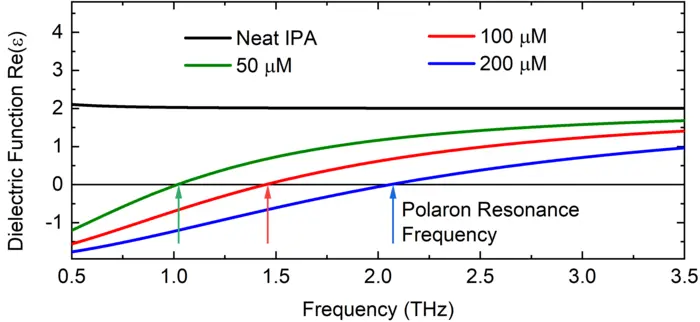In an exciting breakthrough that pushes the boundaries of photonics and materials science, researchers at the Max Born Institute in Berlin and Tulane University in New Orleans have discovered a novel technique that allows common polar liquids, such as water and alcohols, to be transformed into epsilon-near-zero (ENZ) materials. This transformation occurs at terahertz (THz) frequencies through sophisticated laser experimentation, creating significant implications for the manipulation of light within these media. Conventional optical media are known for their limitations in light speed propagation, but this new development, which involves intense femtosecond laser pulses, offers unprecedented control over light dynamics in liquids.
The fundamental principle behind this transformation lies in the ionization of polar molecular liquids using short femtosecond laser pulses. When subjected to this high-energy optical treatment, the liquids generate free electrons. These electrons localize or ‘solvate’ within the matrix of the molecule, which consists of electric dipoles forming an intricate three-dimensional network. This interaction happens almost instantaneously, occurring on a femtosecond timescale, and initiates a series of complex electrostatic dynamics within the liquid.
Within this setting, the binding energy of the electrons depends principally on the electric interactions between these solvated electrons and the nearby molecular dipoles. The laser-induced ionization not only produces free electrons but also leads to collective oscillations that kick-start a many-body excitation termed a polaron. The polaron represents a quasiparticle composed of an electron and its surrounding polarized medium. In this context, the polaron frequency is critical, as it determines the characteristic dielectric properties of the liquid as it interacts with light.
As demonstrated in the recent study showcased in Physical Review Letters, the research team effectively monitored light propagation through these excitatively modified liquids. They detailed how the introduction of free electrons gives rise to a polaron resonance frequency, making the dielectric function of the liquid intersect with the zero line at specific frequencies. When the conditions are right, at the polaron frequency, the phase velocity of light approaches an infinity limit, while the group velocity dramatically diminishes to nearly zero. Such phenomena exemplify traits typical of ENZ materials and elucidate profound changes in light wave dynamics.
The experiments conducted involved sending short THz pulses through the modified polar liquids, wherein the ensuing interactions led to dramatic alterations in both phase and group velocities compared to traditional liquids. Astonishingly, the research revealed that the polaron frequency could be tuned simply by varying the concentration of electrons within the liquid. This adjustability presents an enticing avenue for engineering materials with specific ENZ properties, greatly expanding the functional capacity of optical devices.
Significantly, the team observed these alterations to the THz pulse envelope, noting reshaping due to interactions with the polarons. This reshaping was visually stark when contrasting the transmitted THz pulses within the modified liquids against those propagated through virgin liquid and vacuum settings. The results underscore an extraordinary capacity for engineering light propagation behavior through liquid media tailored for specific applications, ultimately paving the way for innovative approaches in optical sensing and communication.
Beyond their immediate findings, the implications of such technology stretch into various fields. Researchers anticipate that enacting careful control over the polaron frequency could lead to the development of advanced devices capable of harnessing light in ways previously understood only theoretically. The ability to tune the light manipulation properties within liquid media could revolutionize how information is transmitted and sensed, from ultra-sensitive detectors to novel forms of communication technology predicated on fluid photonics.
The research not only broadens the frontiers of material science but also draws attention to the interplay between theoretical foundations and experimental validation. The convergence of sophisticated modeling with hands-on experimentation in this domain fuels a greater understanding of how light interacts with matter, particularly in non-traditional media like polar liquids. Scholars and scientists in the field can rally around these monumental findings as they provide fertile ground for future research endeavors.
Ultimately, the emergence of polar liquids as a new class of ENZ materials opens a multitude of possibilities. It raises invigorating questions and potential applications that could alter how we perceive and utilize optical technologies. As the frontier between conventional media and engineered materials blurs, the implications for both academic inquiry and commercial technology remain ripe for exploration.
This work reflects not only a significant step in physics and engineering but a testament to human ingenuity and the perpetual quest for knowledge that drives scientific discovery. It serves as a reminder that even the most common substances can hold secrets of profound complexity and utility when examined through a lens of innovation and experimentation. The collaborative efforts in this research underline the importance of interdisciplinary approaches in propelling scientific advancements, as chemists, physicists, and engineers work in concert to unravel the mysteries surrounding the optical behavior of materials.
Through such groundbreaking discoveries, the path forward appears promising, as researchers build on these achievements of manipulating light properties in liquid states. The intersectionality of laser physics and material science creates a hotbed for innovation, possibly leading to solutions for pressing technological challenges we face today in communication, information processing, and beyond. As the work continues on this front, the scientific community eagerly anticipates the next revelations that may emerge from studies focused on the complexities of light in its various forms.
Subject of Research: Epsilon-Near-Zero Materials in Polar Liquids
Article Title: Transforming Polar Liquids into Epsilon-Near-Zero Materials
News Publication Date: February 5, 2025
Web References: Physical Review Letters
References: doi.org/10.1103/PhysRevLett.134.056901
Image Credits: Credit: MBI/Dr. M. Runge
Keywords
Epsilon-near-zero materials, Terahertz frequencies, Femtosecond laser pulses, Polaron frequency, Light propagation, Optical media, Material science, Polar liquids, Photonics, Light dynamics, Collective oscillations, Quasiparticle.
Tags: advancements in photonics and materials scienceelectrostatic dynamics in liquidsepsilon-near-zero materialsfemtosecond laser pulsesionization of liquids using laserslight speed propagation in optical mediamanipulation of light in liquidsMax Born Institute research breakthroughsnovel techniques in liquid manipulationoptical techniques for fluid dynamicspolar molecular liquidsterahertz frequency applications





